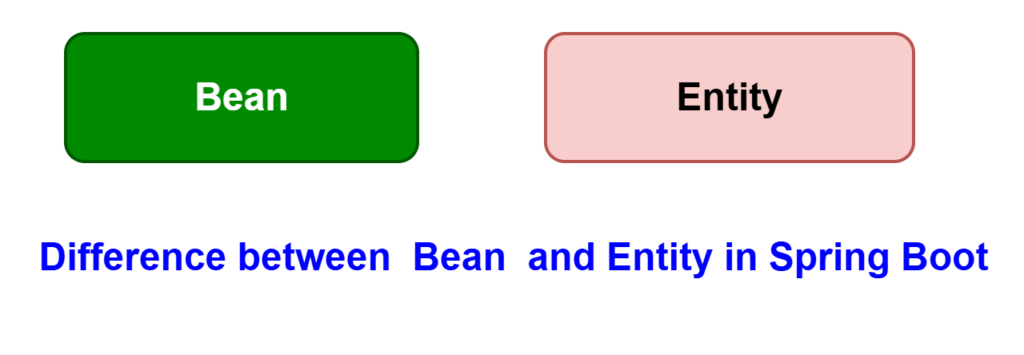In Spring Boot development, the terms Bean and Entity represent two key but distinct concepts of Java classes. This topic will highlight the difference between Bean and Entity, including their purpose, usage, and framework dependencies.

Bean in Spring Boot
In Spring Boot we are creating two types of bean classes are Java Bean and Spring Bean. A Java Bean need to create object manually and a Spring Bean’s object is managed by the Spring container.
Key Characteristics of Spring Bean
- Created and managed by Spring.
- This annotated with annotations like @Component, @Service, @Repository, or configured via @Bean.
- Supports dependency injection.
- This can be be used in any layer: controller, service, repository, config, etc.
Example:
@Service
public class EmailService {
public void sendEmail(String to, String body) {
System.out.println("Sending email to " + to);
}
}Entity in Spring Boot
A Java Bean class is annotated with @Entity annotation. This is used for data persistence and communicates with the database with the help of Spring Data JPA or Hibernate.
Key Characteristics
- Annotated with @Entity.
- Must have a field annotated with @Id (primary key). Supports relationships like OneToMany, etc..
Example:
@Entity
public class User {
@Id
@GeneratedValue(strategy = GenerationType.IDENTITY)
private Long id; private String name;
private String email;
// Getters and Setters
}Key Difference Between Bean and Entity
| Feature | Spring Bean | Entity |
| Primary Role | Business logic, configuration, service objects | Represents a database table for persistence operation |
| Framework Dependency | Spring Framework | JPA, Hibernate |
| Annotations | @Component, @Service, and etc. | @Entity, @Id, etc… |
| Managed By | Spring container | JPA/Hibernate |
| Persistence | No | Yes |
| Use Case | Service layer, controller layer, config classes | Data access layer (entities managed in DB) |
| Injection Support | Yes (using @Autowired) | Yes (used in repositories but not directly injected) |
| Lifecycle | Control Full Spring lifecycle (init/destroy methods) | Managed during database sessions |
When to Use Bean vs Entity
Use Spring Bean When
- We want the class to be managed by Spring container.
- We are implementing business logic.
- We want to inject the class using @Autowired.
Use Entity When
- When we want to persist data to a database.
- When we are using Spring Data JPA.
Can an Entity Also Be a Bean?
Technically, yes — but it’s not recommended to treat an entity as a Spring Bean. JPA entities should be treated as plain data models, and should not contain business logic or be injected like beans. Beans are meant for logic and services, while entities are meant for state and structure.
Real-World Scenario
UserController → UserService → UserRepository → Entity- UserService and UserRepository are Beans.
- User is an Entity, persisted via the repository.
- We inject beans into other components using @Autowired, but you do not inject entities.
Conclusion
In Spring Boot:
- A Bean is a Spring-managed object that plays a role in the logic and configuration of our app.
- An Entity is a JPA-managed object that maps to a database table.
